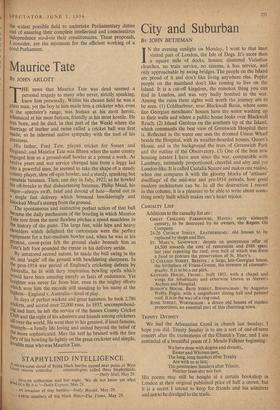City and Suburban
BY JOHN BETJEMAN IN the evening sunlight on Monday, I went to that least visited part of London, the Isle of Dogs. It's more than a square mile of docks, houses: shattered Victorian churches, no train service, no cinema, a bus service, and only approachable by swing bridges. The people on the Island are proud of it and don't like living anywhere else. Poplar people on the mainland don't like coming to live on the Island. It is a cut-off kingdom, the remotest thing you can find in London, and was very badly bombed in the war. Among the ruins three sights well worth the journey are to be seen. (1) Coldharbour, near Blackwall Basin, where some fine Georgian merchants' houses have the water washing up to their walls and where a public house looks over Blackwall Reach. (2) Island Gardens on the southern tip of the Island, which commands the best view of Greenwich Hospital there is. Reflected in the water one sees the doomed Union Wharf beside the Hospital, with its weather-boarded houses, Queen's House, and in the background the trees of Greenwich Park and the outline of the Observatory. (3) One of the best new housing estates I have seen since the war, comparable with Lansbury, intimately proportioned, cheerful and airy and yet London-like. It is called Castalia Square and makes one realise. when one compares it with the gloomy blocks of 'artisans' dwellings' of the mid-war and pre-1914 periods, how good modern architecture can be. In all the destruction I record in this column, it is a pleasure to be able to write about some- thing newly built which makes one's heart rejoice.
CASUALTY LIST
Additions to the casualty list are : GREAT CHILLING FARMHOUSE, HANTS: early sixteenth century, to be destroyed by its owners, the Regent Oil Company. 24-26 CHURCH STREET, LEATHERHEAD: old houses to be replaced by shops and flats. ST. MARY'S, SANDWICH: despite an anonymous offer of £4,500 towards the cost of restoration and £988 spent last year repairing the roof, over half of which was from a fund to procure the preservation of St. Mary's. 12 COLLEGE STREET, BRISTOL: a large, late-Georgian house, the birthplace of Friese-Greene, the inventor of cinemato- graphy. It is to be a car pirk. KEYI'ORD HOUSE, Faom : built 1803, with a chapel and wings for inhabitants and otherwise known as Steven's Asylum and Hospital. BISHOP'S HOUSE, BATH STREET, BIRMINGHAM: by Augustus Welby Pugin, with a magnificent dining hall and painted roof. It is in the way of a ring road..
ROSE STREET, WOKINGHAM : a dozen old houses of modest proportions, an essential part of this charming town.
TRINITY DIVINITY
We had the Athanasian Creed in church last Sunday; I hope you did. Trinity Sunday is to me a sort of end-of-term concert after the excitements of the Church's Year, and I am reminded of a beautiful poem of J. Meade Falkner beginning :
We have done with dogma and divinity, Easter and Whitsun past, The long, long Sundays after Trinity Are with us at last; The passionless Sundays after Trinity, Neither feast-day nor fast.
His poems may still be bought at a certain bookshop in London at their original published price of half a crown, but it is a secret I intend to keep for friends and his admirers and not to be divulged to the trade.


































 Previous page
Previous page